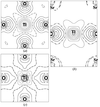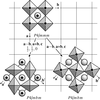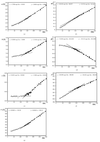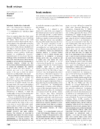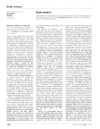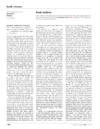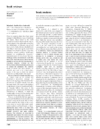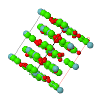issue contents
August 2002 issue

Cover illustration: The structure of remacemide nitrate (C17H21N2O+·NO3-) solved from powder diffraction data using a global optimization approach based on maximum likelihood. Only the remacemide molecule is optimized while the nitrate ion is treated as an unknown blur [Markvardsen, David & Shankland, Acta Cryst. (2002), A58. Submitted]. Image produced by Dr A. Florence, University of Strathclyde, Scotland, using POV-ray 3.1.
research papers
Topological analysis of the electron density and the local kinetic, potential and total electronic energies was performed for the cubic SrTiO3 crystal using a multipole model fitted to the experimental and theoretical X-ray diffraction structure factors.
The short-range order of the amorphous tungsten oxide obtained by thermal evaporation of WO3 powder in a vacuum and anodic amorphous tungsten oxide has been investigated by X-ray methods and molecular dynamics simulations.
Combining information from X-ray diffraction, selected-area electron diffraction, high-resolution transmission electron microscopy and image simulation, a structural model is derived for trititanate nanotubes.
Family trees of symmetry relationships among derivatives of the perovskite structure have been set up using crystallographic group–subgroup relations. 56 known structure types exhibiting various kinds of distortions and atom substitutions have been interrelated.
Download citation


Download citation


The ordered structure of LiTaOGeO4 at 173 K and its transition to the paraphase at Tc = 231 K are reported. Similarities to the structure and phase transitions of titanite, CaTiOSiO4, and related compounds are discussed. Anharmonic thermal displacement of the Li atom is analyzed and a one-particle description of Li site disorder in the paraphase is obtained.
Download citation


Download citation


The crystal structure of a new phase of dicalcium silicate (Ca2SiO4) has been determined by simulated annealing and refined by the Rietveld method using synchrotron radiation powder diffraction data. The mechanism of structural changes from α-dicalcium silicate hydrate to  -dicalcium silicate via the new phase is discussed.
-dicalcium silicate via the new phase is discussed.
Ytterbium iodine phthalocyanine, [YbPc2]I2 (YPI), presents an example of a disordered modulated crystal structure of the intergrowth type. The short-range order in YPI of both ytterbium ions and of iodine chains [ ]n has been determined by X-ray diffuse scattering.
]n has been determined by X-ray diffuse scattering.
Download citation


Download citation


The very short hydrogen bonds in potassium hydrogen dichloromaleate have been studied by neutron diffraction at 170 K and 90 K. The hydrogen bonds are asymmetric although the environment is centrosymmetric, in complete agreement with our earlier studies at 295 K and 30 K.
The approximate kinetic, potential and electronic energy densities calculated using the density functional theory formulae and model electron density derived from experimental structure factors are studied. The use of these functions for quantitative characterization of bonding in molecules and crystals is demonstrated.
A molecular database, CSDSymmetry, with nearly 200 000 entries, has been constructed. This database allows flexible and easy searching for relationships between molecular and crystallographic symmetry.
A second blind test of crystal structure prediction for three organic molecules is reported, using the principal computer programs currently available. A correct prediction based on energy was found for the two rigid molecules but not for the third flexible molecule.
The basic principles of a model predicting new lattices from a known crystal structure are described. The first of the two-step procedure consists of extracting one- or two-dimensional periodic fragments from the mother structure. In the second step, symmetry operators are added to the periodic fragments in order to generate one or several new three-dimensional lattices consistent with the 230 space groups.
Download citation


Download citation


Two subsets of data, corresponding to different crystalline modifications of the title compound, have been obtained from the same experiment. Both structures were successfully solved and refined. The packing of identical layers of molecules is different for monoclinic and orthorhombic forms.
Thermal motion is crucial in explaining the discrepancies between molecular modelling and experiment with respect to the structures and relative stabilities of the polymorphs of even n-alkanes.
Download citation


Download citation


The 4-isopropylphenol crystal structure, thermal expansion and rigid-body analysis of anisotropic displacement parameters were studied in the 95–300 K range.
Download citation


Download citation


The nature of the hydrogen bonding in two organic non-linear optical compounds, MBANP and MBADNP, as determined by neutron diffraction, is related to their differing second-harmonic generation outputs. A charge-density study of MBADNP elucidates the nature of the highly influential intramolecular hydrogen bond and also reveals the nature of the polarizability within the molecule.
Download citation


Download citation


In iodo-nitroanilines, the molecules can be linked by N—H⋯O hydrogen bonds, two- or three-centre iodo⋯nitro interactions and aromatic π⋯π stacking interactions. The resulting supramolecular structures can be two- or three-dimensional.
Download citation


Download citation


A detailed analysis of hydrogen-bond networks in solvent-free and solvated ecdysteroid crystals allows an interpretation of the role of molecular structure modifications in crystal packing and in solvent incorporation into the lattice.
Download citation


Download citation


The charge density of a hexapeptide was determined from high-resolution CCD area-detector experiments at 100 K. Two datasets, one from a rotating anode and a second one from synchrotron radiation, were measured and the results are compared.
Download citation


Download citation


The separation of antiferroelectric molecular layers in α-glycine increases over the temperature range in which these crystals display anomalous electronic properties and is driven by an increase in molecular libration.
Download citation


Download citation


Unlike in other complexes involving DL- and L-amino acids, the aggregation patterns in the DL-histidine and L-histidine complexes of malonic acid remain almost exactly the same, with considerable conformational strain in one of the two crystallographically independent histidinium ions in the L-histidine complex.
book reviews
Free 

books received
Free 

Free 

Free 



 journal menu
journal menu









